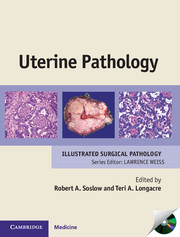Book contents
- Frontmatter
- Contents
- List of contributors
- Preface
- Acknowledgments
- 1 Cytology of the uterine cervix and corpus
- 2 Cervix: squamous cell carcinoma and precursors
- 3 Cervix: adenocarcinoma and precursors, including variants
- 4 Miscellaneous cervical abnormalities
- 5 Non-neoplastic endometrium
- 6 Endometrial carcinoma precursors: hyperplasia and endometrial intraepithelial neoplasia
- 7 Endometrioid adenocarcinoma
- 8 Serous adenocarcinoma
- 9 Clear cell adenocarcinoma and other uterine corpus carcinomas, including unusual variants
- 10 Carcinosarcoma
- 11 Adenofibroma and adenosarcoma
- 12 Uterine smooth muscle tumors
- 13 Endometrial stromal tumors
- 14 Other uterine mesenchymal tumors
- 15 Miscellaneous primary uterine tumors
- 16 Uterine metastases: cervix and corpus
- 17 Gestational trophoblastic disease
- 18 Other pregnancy-related abnormalities
- 19 Lynch syndrome (hereditary non-polyposis colorectal cancer syndrome)
- 20 Cytology of peritoneum and abdominal washings
- Index
- References
13 - Endometrial stromal tumors
Published online by Cambridge University Press: 05 July 2013
- Frontmatter
- Contents
- List of contributors
- Preface
- Acknowledgments
- 1 Cytology of the uterine cervix and corpus
- 2 Cervix: squamous cell carcinoma and precursors
- 3 Cervix: adenocarcinoma and precursors, including variants
- 4 Miscellaneous cervical abnormalities
- 5 Non-neoplastic endometrium
- 6 Endometrial carcinoma precursors: hyperplasia and endometrial intraepithelial neoplasia
- 7 Endometrioid adenocarcinoma
- 8 Serous adenocarcinoma
- 9 Clear cell adenocarcinoma and other uterine corpus carcinomas, including unusual variants
- 10 Carcinosarcoma
- 11 Adenofibroma and adenosarcoma
- 12 Uterine smooth muscle tumors
- 13 Endometrial stromal tumors
- 14 Other uterine mesenchymal tumors
- 15 Miscellaneous primary uterine tumors
- 16 Uterine metastases: cervix and corpus
- 17 Gestational trophoblastic disease
- 18 Other pregnancy-related abnormalities
- 19 Lynch syndrome (hereditary non-polyposis colorectal cancer syndrome)
- 20 Cytology of peritoneum and abdominal washings
- Index
- References
Summary
INTRODUCTION
Endometrial stromal neoplasms consist of endometrial stromal nodule and low-grade endometrial stromal sarcoma. Low-grade endometrial stromal sarcomas (ESSs) are uncommon uterine malignancies that constitute less than 20% of uterine sarcomas. Although a relatively rare disease, endometrial stromal sarcoma can pose many diagnostic problems, including the necessity to distinguish it from endometrial stromal nodule on the one hand and high-grade sarcoma on the other. These issues have an important impact on surgical management and selection of adjuvant therapy. That they are indolent tumors makes studying the natural history of these tumors complex; many patients become lost to follow-up or die of unrelated causes, which complicates surveillance for recurrence. Low-grade endometrial stromal sarcoma is distinguished from undifferentiated endometrial sarcoma on the basis of morphology and substantial differences in clinical presentation and survival.
CLINICAL CHARACTERISTICS
The mean age of patients with low-grade endometrial stromal sarcoma is in the fifth decade. At least half of affected patients are premenopausal. The disease tends to present like other endometrial tumors, with vaginal bleeding being common. Another typical presentation is a polypoid mass. There are occasional reports of endometrial stromal sarcoma developing after tamoxifen therapy.
Most low-grade endometrial stromal sarcomas are diagnosed in hysterectomy specimens. The diagnosis can also sometimes be suggested in myomectomy and curettage specimens and on imaging studies, but a firm diagnosis of endometrial stromal sarcoma can only be substantiated when the tumor/myometrial interface is available for examination.
- Type
- Chapter
- Information
- Uterine Pathology , pp. 251 - 263Publisher: Cambridge University PressPrint publication year: 2012



